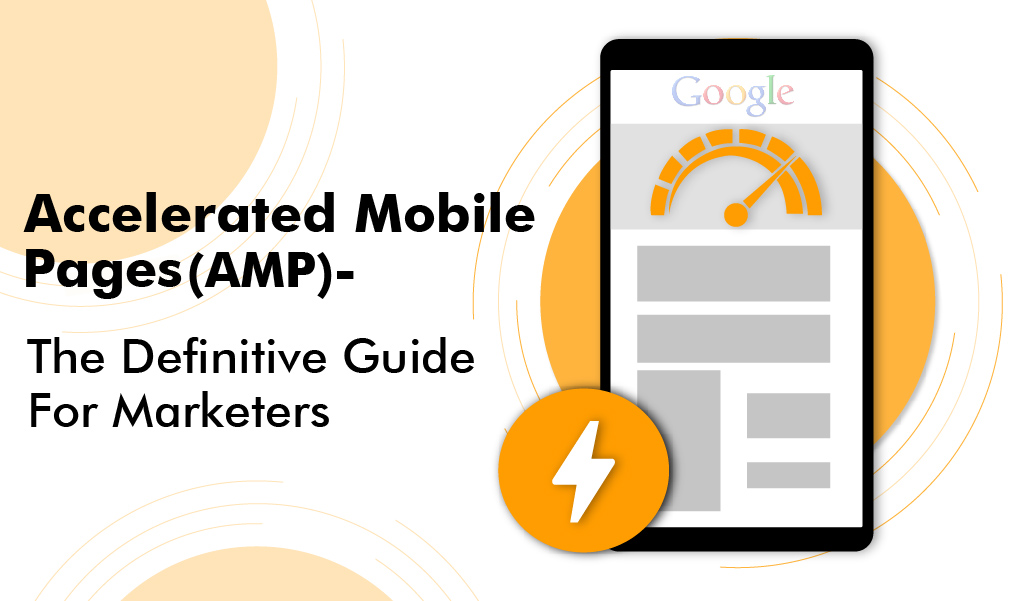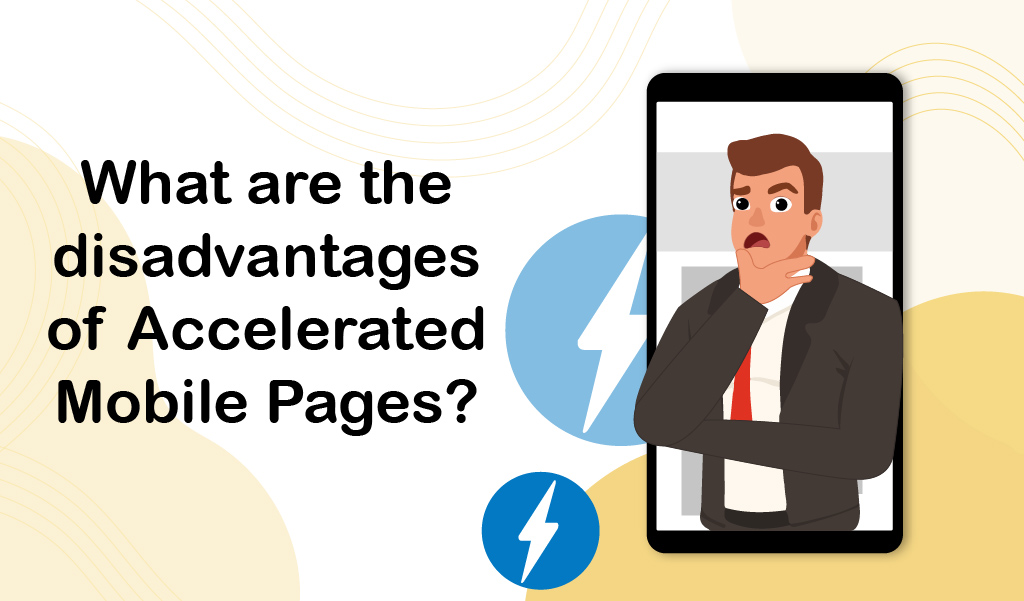Accelerated Mobile Pages (AMP): The Definitive Guide for Marketers
Table of contents

Speed has become the most important factor when it comes to your website because the longer your page will take to load; the more traffic you will lose. Moreover, Google also launched its mobile-friendliness update a few years ago and made page load speed one of its search ranking factors. Hence, now the load speed will also affect your position in search engine results pages. This is where mobile accelerated pages (AMP) can help you. It is the framework that provides the developers the means to optimize their sites for faster, cleaner, and more efficient delivery on mobile.
In this post, you will learn everything about AMP and know exactly what Accelerated Mobile Pages are and how will they reap big rewards for your website by the end of this article.
So, let us begin with understanding this term in detail.
What is Accelerated Mobile Pages (AMP)?
As already discussed, AMP is a Google-backed project that aims to speed up the delivery of your content on mobile devices. It is actually an open-source framework developed by Google in collaboration with Twitter to create a better and faster experience on the mobile web. At its core, this framework will simplify the HTML and the following streamlined CSS rules, thus allowing you to build a lightweight experience for mobile.
Originally, Accelerated Mobile Page or AMP was considered to be developed in response to Facebook’s Instant Articles but over the period of years, it became a powerful platform for delivering content at the most lightning speed.
In a nutshell, we can say that the pages which are AMP-optimized will load faster and hence rank better than the other mobile web pages as page speed is the confirmed ranking factor.
How does Accelerated Mobile Page work?
In February 2016, there was a need to build a framework for creating an optimized, tightly integrated user experience instead of the slow and clunky mobile experiences that users deal with on a daily basis. Hence, Google launched the Accelerated Mobile Pages (AMP) open-source. AMP generally consists of 3 main parts that include:
- AMP HTML:
This is the leaner version of HTML that ensures quicker page loading. While the AMP framework has strict rules for the HTML tags, certain HTML elements like forms are not allowed on AMP to ensure fast page loading. The use of a streamlined version of CSS is also required by AMP. You would not have any difficulty in adapting the existing pages to AMP HTML if you are already familiar with regular HTML.
- AMP JS:
AMP restricts the use of any JavaScript in order to ensure a fast page load on mobile platforms. While you can make use of AMP JS which is optimized with page load acceleration in mind. AMP also provides us with a library of easy-to-implement components as compensation for the restriction of JavaScript. This library ensures the fast rendering of AMP HTML pages and it also implements the AMP’s best performance practices such as inline CSS and front triggering. This manages resource loading and provides you the custom HTML tags that ensure a fast page rendering. You can load content dynamically, create animations, modify the layout, and much more with AMP JS, as nothing can block anything from rendering as it makes everything from the external resources asynchronous. In addition to this, there is an AMP component for GDPR compliance too.
- AMP CDN:
The proxy-based content delivery network (CDN) also known as AMP cache is the final component of AMP that collects AMP content to cache it for quick delivery. By default, the AMP CDN caches all the valid AMP content and it does not provide an opt-out option. AMP cache comes with a built-in validation system which confirms that the page is guaranteed to work while not depending on the external forces that could slow it down.
This system operates on a series of assertions that confirms whether the page’s markup meets the AMP HTML specs or not. While an additional version of the validation system is available alongside every AMP page that is able to log validation errors directly into the browser’s console when the page is rendered. This enables you to see the complex changes in your code that will have a drastic impact on performance and user experience. However, you can leverage your own CDN provider to customize your content delivery configurations on the top of the AMP cache.
What are the benefits of Accelerated Mobile Pages?

There are a number of key advantages of AMP that separate its adopters from everybody else. They are as follows:
- Speed
The primary function of AMP is to speed up the web performance on the mobile device while it does it to a stunning effect. AMP pages load about twice as fast as a comparable mobile page even with all the technological advances in mobile internet.
- Flexibility
AMP allows you to monetize your pages better by getting rid of distractions on mobile browser pages and thus experience six times lighter code.
- Search Performance
An AMP result is likely to rank much higher than a regular mobile page when somebody makes a search as accelerated mobile pages are favored by Google. Thus helping you boost your visibility on the search engine and gain much more organic traffic.
- Easy to Operate
AMP pages have all the personalization and interactive features that a regular HTML page has, hence, they are relatively easier to operate. Moreover, AMP pages, experience lighter functionality and accelerated web loading pages without any heavy tools.
- Behavior Metrics
Behavior metrics bounce rate, average session duration, and pages viewed per session are key indications of a quality website to the ranking algorithms. AMP contributes to the enhancement of these metrics thus demonstrates that your website is user-friendly.
- Competition
Apart from just being a great way to increase traffic and improve user experience, the accelerated mobile page is also a sure-fire way to get ahead of your competition. If you have got AMP installed, your website is likely to benefit as a whole from the improved average metrics offered by AMP as well as rank it higher on the search engine. On the other hand, if all your competitors have AMP and you don’t, you will suffer as they move ahead.
- Increase conversions
A lightning-fast mobile website can help you increase your conversion rates as it is actually thought that a one-second delay in page loading time will decrease your conversion rate by 7%. While the increase in every second after that will keep dropping your conversion rate.
- High Return On Invest
As the conversion rate increases, the web page can generate even greater earnings thus generating a higher ROI.
Here are some more tips to improve your ROI
- Improves server response
The web framework helps in improving the server performance by reducing the load on the server as AMP material is pre-fetched. Thus helping in improving the server responses and faster load time as stated earlier.
What are the disadvantages of Accelerated Mobile Pages?

Everything might seem amazing so far. But before you get started implementing AMP on your website, there are a couple of disadvantages that you need to consider.
- Reduced User Experience
Though AMP is lightning fast which helps improve the user experience, the way of making web pages load so quickly also reduces the user experience. Because the webpages must be completely stripped back to fast-loading essentials for AMP to work. This means the things like video, menus, forms, maps, and images will not be included which are crucial to enhance the user experience.
- Technical Skills Required
Though this is not the most complicated process to implement, the people who do not have any technical skills will struggle or even will need to hire somebody to do it for them. In addition to this, you may also face the problem of tracking the analytics of your accelerated mobile pages. Because it can be a slightly technical process to link them together while Google analytics will not automatically sync up with these pages. However, with help of some plugins, you can easily implement Accelerated Mobile Pages for your website.
- Implementation is not straightforward
Though the implementing guidelines for the AMP project are user-friendly, conflicting information and consistent updates can make it confusing. Some content management systems like WordPress may have AMP integration tools available but they often conflict with popular SEO tools like Yoast. As a result, implementing AMP is not easy.
What are the techniques to optimize Accelerated Mobile Pages?

Now that you know the core components, advantages, and disadvantages of the AMP framework, let us go over the optimization techniques that make the quickly-loading pages possible.
Asynchronous JavaScript execution
JavaScript tends to block DOM construction and delay page rendering. Hence, AMP only uses asynchronous JavaScript. Because it is important to ensure that JavaScript does not delay rendering, or else it will directly affect the page load speed.
Static size for all resources
Before loading the resources, AMP determines the size and position of each element. Hence, any external resources like images or ads have to state their HTML size. As a result, AMP will load the layout of the page without waiting for any resources to download by utilizing this information.
Extension mechanism
AMP allows extensions for elements such as lightboxes and social media embeds and blocks a lot of unnecessary JavaScript, CSS, and HTML for speeding up the loading time of the page.
No use of third-party JavaScript
Third-party JavaScript usually slows down the load time because of synchronous loading. Hence, AMP pages only allow JavaScript in sandbox iframes as it cannot block the execution of the main page.
Inline and size-bound CSS
CSS delays rendering and it also tends to cause bloating. So, AMP HTML makes use of inline style so that it can remove many HTTP requests to web pages. While 50 KB should be kept open for inline CSS which will be enough space for sophisticated web pages.
Efficient font triggering
While a typical page consists of sync scripts and a couple of external styles, the browser does not download the fonts until the scripts are loaded.
Running only GPU-accelerated animations
Usually, GPU acceleration is required for heavy animations as it performs all its tasks in layers. But GPU cannot update the page layout and gives the task to the web browser, which is not efficient from a speed perspective.
Prioritization of resource loading
Prioritizing resource loading is one of the ways by which AMP maintains fast speed as it only loads resources when needed and pre-fetches the lazy-loaded resources.
Instant loading of pages
As AMPs are rendered even before a user points towards a page they would like to navigate, they are loaded instantly. This is made possible through AMP pre-connect API without using a CPU or a lot of bandwidth.
Mobile has taken over the desktop and has become the world’s favorite internet device today. While the gap between the two will keep growing eventually. Thus, AMP will be the best option for anybody who has pages that are primarily text and image-based. Moreover, if your mobile pages are experiencing high bounce rates and low visitor engagement, then these accelerated mobile pages will create a significant impact by boosting the speed of your webpages and make a big difference to your organic traffic, brand awareness, as well as conversions.
If you are still not sure about AMP pages, then take a look at the data below:
7% of conversions are reduced due to a one-second lag in the website load time.
80% of all the mobile data traffic appears from smartphones as per the 2020 analysis.
While it was found that 58% of the researchers were carried over mobile devices in a 2016 study. Hence, we can conclude that Google accelerated mobile pages should be a part of your SEO strategy sooner than later. So, as a Jacksonville SEO company, we would suggest you start creating accelerated mobile pages today in order to create a better mobile browsing experience, generate more conversions, and improve your quality scores.







